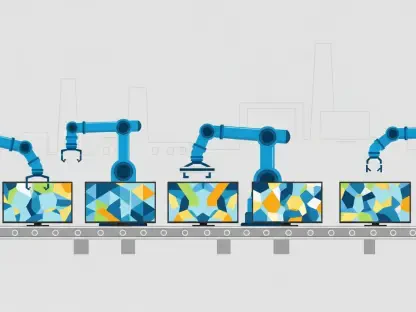In an era where industrial digitalization is reshaping entire sectors, Samsara has emerged as a standout performer in the Industrial Internet of Things (IoT) landscape, delivering exceptional results in the second quarter of fiscal year 2025. With revenue soaring 30% year-over-year to $391.5 million and annual recurring revenue (ARR) matching that growth at $1.64 billion, the company has demonstrated not just financial strength but a deep commitment to innovation. This achievement reflects a broader trend of industries like transportation, logistics, and construction increasingly relying on connected operations to tackle modern challenges. Samsara’s ability to harness cutting-edge technology, particularly artificial intelligence (AI), positions it at the forefront of this transformation, offering solutions that drive efficiency and safety. As global demand for such tools intensifies, the company’s trajectory offers a compelling glimpse into the future of industrial automation and operational excellence.
Financial Performance and Business Maturity
Q2 Financial Highlights
Samsara’s financial performance in the recent quarter underscores a business model that balances rapid growth with increasing profitability. The company reported a striking 30% year-over-year revenue increase to $391.5 million, paired with a similar rise in ARR to $1.64 billion, signaling robust demand for its offerings. Beyond top-line growth, margin improvements paint a picture of operational maturity, with non-GAAP gross margin reaching 78% and non-GAAP operating margin climbing to 15%, a significant leap from prior periods. Additionally, adjusted free cash flow of $44.2 million highlights disciplined financial management. With 98% of sales stemming from recurring subscriptions, Samsara ensures a predictable revenue stream, a critical factor in volatile economic conditions. This combination of growth and stability makes the company a notable contender in the SaaS and IoT arenas, appealing to investors seeking reliable, high-margin opportunities.
Delving deeper into the financial narrative, Samsara’s focus on sustainable expansion sets it apart from peers still prioritizing growth over profitability. The improvement in operating margin by 9 percentage points year-over-year reflects strategic cost control and operational efficiency, while the non-GAAP earnings per share of $0.12 exceeded expectations by over 71%. This performance indicates a shift from a growth-at-all-costs mindset to one that values long-term financial health. The subscription-based model not only drives consistency but also builds a foundation for scalability, allowing reinvestment into innovation without sacrificing fiscal discipline. As macroeconomic uncertainties persist, such metrics provide a buffer, positioning Samsara to weather potential downturns while continuing to expand its footprint in the industrial IoT space. This financial resilience is a key indicator of the company’s readiness for future challenges and opportunities.
Operational Discipline and Market Confidence
Beyond raw numbers, Samsara’s financial strategy reveals a commitment to creating lasting value for stakeholders. The high proportion of recurring revenue—nearly all of its sales—reduces dependency on one-time transactions, fostering a stable cash flow environment. This predictability is further evidenced by the company’s ability to generate positive adjusted free cash flow, a metric often scrutinized by analysts as a sign of operational health. Such discipline has not gone unnoticed, as investor confidence in cash-generative SaaS companies continues to grow, especially amidst stabilizing interest rates. Samsara’s performance aligns with this trend, offering a compelling case for those looking at long-term plays in technology-driven sectors. This financial foundation supports not just current success but also the capacity to fund future innovations.
Equally important is how these financial achievements translate into market positioning. Samsara’s ability to improve margins while scaling revenue suggests a business that has fine-tuned its operations for efficiency without compromising on growth. The substantial year-over-year gains in key profitability metrics demonstrate a maturing approach, one that prioritizes sustainable expansion over short-term gains. This balance is critical in the competitive IoT landscape, where differentiation often hinges on a company’s ability to deliver consistent returns. As Samsara continues to build on this momentum, its financial health serves as a signal to the market of reliability and foresight, reinforcing trust among existing clients and attracting potential new ones. This dual focus on growth and stability underscores a strategic vision geared toward enduring success.
Innovation and Customer Impact
AI-Driven Operational Efficiency
At the heart of Samsara’s appeal lies its innovative use of AI to transform industrial operations across diverse sectors. Leveraging a massive dataset—including 20 trillion annual data points, 90 billion miles traveled, and 300 million digitized workflows—the company’s tools like AI Multicam and predictive maintenance solutions deliver measurable improvements in safety and productivity. A striking case is Maxim Crane, which saved $13 million in downtime costs by utilizing Samsara’s technology to anticipate equipment issues before they escalated. This real-world impact illustrates how AI converts raw data into actionable insights, enabling clients in transportation, logistics, and construction to optimize operations. Such capabilities not only enhance client outcomes but also solidify Samsara’s reputation as a leader in driving efficiency through connected technologies.
Further exploring this innovation, Samsara’s AI tools are tailored to address specific pain points in industrial settings, from reducing accidents through advanced monitoring to streamlining workflows with commercial navigation systems. The sheer scale of data processed allows for highly personalized solutions, ensuring that clients receive value directly aligned with their operational needs. Unlike generic software offerings, these tools adapt to the unique challenges of each industry, whether it’s minimizing fleet downtime or ensuring worker safety on construction sites. This targeted approach has fostered deep client reliance, as businesses increasingly view Samsara’s platform as integral to their day-to-day functioning. As digital transformation accelerates across sectors, the company’s ability to stay ahead with AI-driven solutions positions it as a critical partner in navigating complex operational landscapes.
Customer Retention and Expansion
Samsara’s success is also deeply tied to its ability to build and maintain strong client relationships, evidenced by a 94% retention rate among large customers using multiple products. This loyalty is particularly pronounced among enterprise clients, with those generating over $1 million in ARR contributing more than 20% of total ARR. The number of customers with ARR exceeding $100,000 surged by 30.7% to 2,771, reflecting growing dependency on the platform. This stickiness creates a powerful flywheel effect, where satisfied clients expand their usage, driving further revenue and enabling reinvestment into product enhancements. Such dynamics highlight how integral Samsara has become to its clients’ operations, ensuring a stable base for future growth in a competitive market.
Examining this trend more closely, the expansion of Samsara’s customer base among high-value clients signals not just adoption but a deepening trust in the platform’s capabilities. Enterprise clients, in particular, are drawn to the comprehensive nature of the solutions, which address multiple facets of their operations from safety to cost management. This broad utility fosters long-term partnerships, as businesses are less likely to switch providers once fully integrated with Samsara’s ecosystem. The resulting increase in customer lifetime value provides a financial cushion, allowing the company to allocate resources toward research and development without immediate pressure for returns. As more industries recognize the benefits of connected operations, Samsara’s focus on retention and expansion is likely to remain a cornerstone of its growth strategy, cementing its market presence.
Market Trends and Growth Opportunities
Macroeconomic Tailwinds
Samsara’s growth is bolstered by a favorable macroeconomic environment that supports technology-driven companies. Stabilizing interest rates have renewed investor confidence in cash-generative SaaS businesses, with deal values in this sector rising by 32.4% in 2024. This trend reflects a broader shift toward valuing predictable revenue models, a strength Samsara exemplifies with its subscription-based approach. Additionally, global challenges such as labor shortages and supply chain disruptions are accelerating demand for automation and AI-driven solutions. These conditions create a ripe landscape for Samsara to capitalize on, as industries seek tools to mitigate operational risks and enhance efficiency. The alignment of these external factors with the company’s core offerings provides a significant boost to its growth trajectory.
Looking at the broader implications, these macroeconomic tailwinds are not merely temporary boosts but indicative of a structural shift in how businesses prioritize technology investments. The growing emphasis on automation to counter labor constraints highlights a pressing need for solutions like those Samsara provides, which streamline operations without requiring extensive human oversight. Meanwhile, the surge in SaaS investments signals a market increasingly receptive to scalable, subscription-based platforms, a model at the core of Samsara’s strategy. As economic conditions continue to stabilize, the company stands to benefit from heightened private equity interest and a general appetite for disciplined growth stories. This supportive backdrop amplifies Samsara’s ability to attract capital and expand its reach, positioning it favorably for sustained success in the industrial IoT space.
Emerging Markets and Sector Growth
Samsara is also well-positioned to tap into untapped regional opportunities, with markets like Japan presenting a $200 billion total addressable market (TAM) by 2026. Such regions offer significant potential for expansion, as digital transformation remains in early stages, creating demand for connected operation platforms. Concurrently, the global SaaS-based supply chain management (SCM) market is projected to grow at a 12.5% compound annual growth rate (CAGR) through 2034, aligning perfectly with Samsara’s expertise. These sector-specific trends underscore a growing reliance on technology to address logistical complexities and operational inefficiencies. By targeting these high-growth areas, Samsara can diversify its revenue streams and establish a foothold in markets poised for rapid digital adoption.
Drilling into the specifics, the opportunity in emerging markets goes beyond mere numbers—it represents a chance to shape industrial practices in regions where legacy systems still dominate. Japan, for instance, faces unique challenges in logistics and infrastructure that Samsara’s AI-driven tools are uniquely equipped to address, from optimizing fleet management to enhancing safety protocols. Similarly, the SCM sector’s robust growth reflects a global push toward supply chain resilience, especially in the wake of recent disruptions. Samsara’s platform, with its focus on real-time data and predictive analytics, offers a direct solution to these pain points, positioning the company as a key enabler of modernization. As these markets and sectors evolve, Samsara’s early mover advantage could translate into lasting dominance, provided it continues to tailor solutions to local and industry-specific needs.
Strategic Alliances and Market Expansion
OEM Partnerships and TAM Growth
Strategic collaborations with original equipment manufacturers (OEMs) such as Hyundai Translead and Rivian are pivotal to Samsara’s market expansion efforts. These partnerships enhance the company’s ability to penetrate new segments by integrating its technology directly into equipment, ensuring seamless data collection and operational insights. Such alliances not only diversify revenue sources but also improve the quality of data feeding into Samsara’s AI models, creating a competitive edge. The result is a rapidly expanding TAM, projected to grow from $137 billion in 2024 to $200 billion by 2026, driven by cross-industry demand for digital solutions focused on safety, sustainability, and cost efficiency. These partnerships are a linchpin in Samsara’s strategy to scale globally while maintaining technological superiority.
Expanding on this theme, the value of OEM relationships lies in their dual benefit of market access and innovation. By embedding its platform into the products of leading manufacturers, Samsara gains direct entry into client ecosystems, reducing adoption barriers and accelerating usage. Simultaneously, the real-time data gathered through these integrations enriches the company’s AI capabilities, enabling more precise and predictive solutions. This symbiotic dynamic fuels TAM growth, as industries beyond traditional strongholds—such as agriculture and energy—begin to recognize the potential of connected operations. As Samsara leverages these alliances to broaden its footprint, the projected TAM increase signals not just opportunity but a validation of the company’s approach to building a scalable, data-driven ecosystem. This strategic focus ensures relevance across evolving market demands.
Building a Competitive Edge
The impact of Samsara’s partnerships extends into establishing a formidable barrier against competitors in the IoT and SaaS spaces. Collaborations with OEMs create a network effect, where each new integration enhances the platform’s value proposition, making it harder for rivals to replicate the depth of insights Samsara offers. This competitive moat is further strengthened by the company’s ability to tailor solutions based on industry-specific data, a direct result of these alliances. As the TAM expands, Samsara’s entrenched position through strategic relationships positions it to capture a disproportionate share of the market. This advantage is critical in a landscape where differentiation often determines long-term success, especially as more players enter the industrial digitalization fray.
Reflecting on the broader implications, these partnerships also serve as a catalyst for innovation within Samsara’s ecosystem. The continuous flow of real-time data from OEM integrations allows for rapid iteration of features, ensuring that the platform remains ahead of emerging client needs. This agility contrasts with slower-moving competitors, providing Samsara with a first-mover advantage in addressing new use cases, from sustainability tracking to enhanced safety measures. Moreover, the credibility gained from working with reputable manufacturers bolsters market trust, attracting additional clients and partners. As the company navigated the complexities of Q2, these alliances proved instrumental in reinforcing its leadership, setting a precedent for how strategic collaboration can drive both immediate results and future potential in the industrial IoT domain. Moving forward, expanding such networks will likely remain a priority to sustain this edge.









